My Digital Garden Philosophy
If you spend time in tech blogging circles, you may have come across the concept of a digital garden, which offers an alternative for how you publish your blog online. Unlike a traditional blog (a reverse-chronological feed of posts like my home page), a digital garden can include everything from brief thoughts to rough notes on a topic. It’s flexible, allowing you to arrange content in a way that suits you, whether as a wiki with interlinked notes or by showcasing your most cultivated works front and center on the home page. And over time, as you nurture your notes, they naturally grow into larger, more polished posts.
As a blogger, there can be a pressure to publish something perfect the first time around, and so the digital garden concept is quite freeing. Being able to tag your content as notes or “seedlings” lowers expectations from your readers, and reduces the barrier of getting something out there.
However I do think there’s still a lot of value in reverse-chronological order. I like showing to other people what I’ve been working on most recently. And when repeat visitors come back to my site, I want them to be able to see what’s new since the last time they visited.
My take on digital gardens
As a concept - a digital garden sounds super cute. Who wouldn’t love equating spending time on the internet with creating something as lovely as a garden? So I still do see my site as my own digital garden, just with a slightly little different spin on it.
I scatter my posts like seeds 🌱
When I write about the mountains that I hike, sometimes my posts can be a niche within a niche. Firstly, I’m catering to the English-speaking hiking community in Japan, which is fairly small as it is. And when I hike a random mountain in rural Yamanashi, chances are that barely anyone is ever going to Google for it.
At the same time, this is my garden. Even if no one’s going to read it, if I’ve hiked it, I want to write about it. So it’s inevitable that some of these posts are going to remain as seedlings forever. And that’s ok!
When my posts start to grow, I tend to them 🪴
I use an analytics provider called Umami, which gives me a dashboard overview of what pages on my site are being visited. After publishing a post, it can sit dormant for many months before it starts to show up in Google search results. But when it does, I’ll see a little uptick in my Umami dashboard. Which is a sign for me to revisit that blog post - are there things I can improve about it? There may have been specific sections I didn’t properly flesh out, like public transport options, so there is usually something for me to improve.
I want to make sure that if people are clicking that post, they are getting the most informative page I can give them. Not to say that my seedling posts are of bad quality - I still like to think I take care in writing each one - but I just want to try a little bit harder for those that are getting views.
Adding fertiliser to my garden 👨🌾
Sometimes my posts need a little helping hand. My theory is that people do want to hike a lot of mountains in Japan, but if they don’t know the name of the mountain, they’re never going to find my posts. So a recent addition to my garden are compilation posts, starting with my favourite day hikes and winter hiking in Tokyo. My hopes are that people will Google looking for hikes, come across this post, and then find their way to my actual hiking logs.
My garden starts to flourish 🌳
The hiking section of my blog is still relatively new, and all my traffic comes from people finding it via Google. I’m now starting to see the occasional comment and Instagram DM trickle in about my content. My hope is that over time, my garden will start to draw in not only new visitors, but also repeat visitors who come back to read my content.
Publishing my notes
The other part of digital gardening that I’m slowly starting to get onboard with is publishing my rough notes. Each of my posts show up on my home page, so I do feel a pressure that if someone is going to click on them, that they are worth reading. However I have a lot of random thoughts and drafts that I don’t think are quite post-worthy. But maybe someone out there would find value in even these?
I’ve started publishing these drafts as notes from my /now page. They’re fairly hidden, so you’d have to specifically go looking for it. But my intention with these is that if someone stumbles onto it via a Google search, and I see it in my Umami dashboard, that would be an indicator for me to start tending to that note and turn it into a proper post 🪴.
On my blog’s current layout
Although I am a fan of my reverse-chronological feed, I do think there is a lot of merit to crafting your blog to accomodate both new visitors and returning visitors. Especially when most people stumble onto my blog from Google search. New visitors probably care a little bit about my latest posts, but they also are interested in my best posts as well.
I haven’t quite settled on a version that I’m happy with, but the current state of my blog is as follows.
Home page
I do want at least one reverse-chronological feed somewhere on my site, so what better place than the home page? You can scroll right down to the bottom here, and all the posts I’ve ever written are displayed on one page. I’ve also color-coded them to match the sections of the blog they are from.
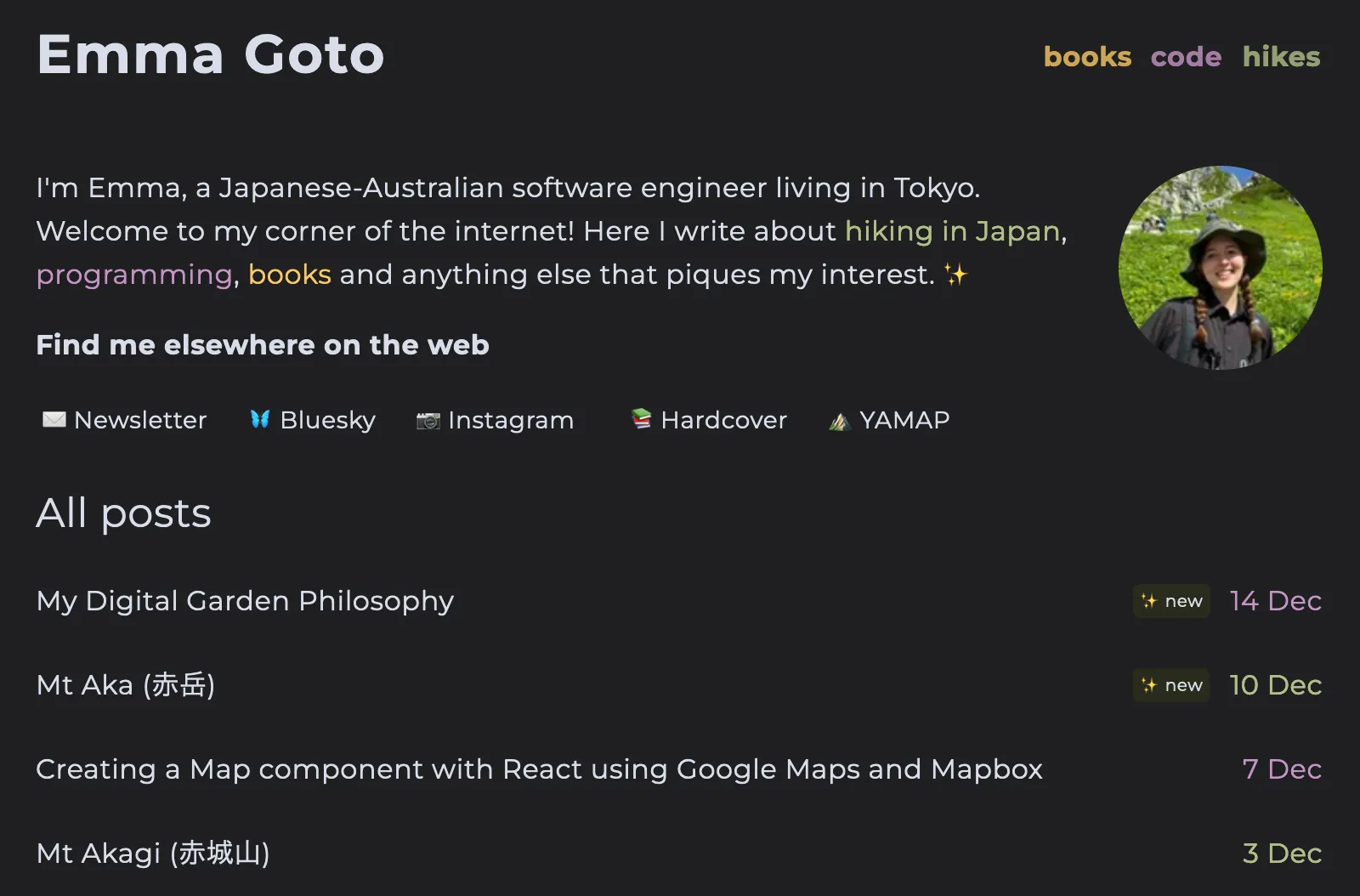
Hiking section
I originally had my hiking section as more reverse-chronological-focused, with some links out to my favourite posts - but I found people weren’t really clicking on them. I’ve restructured it a bit to focus more on a new visitor coming in who’s looking to learn more about hiking in Japan. We’ll see if this structure pays off in 2025.
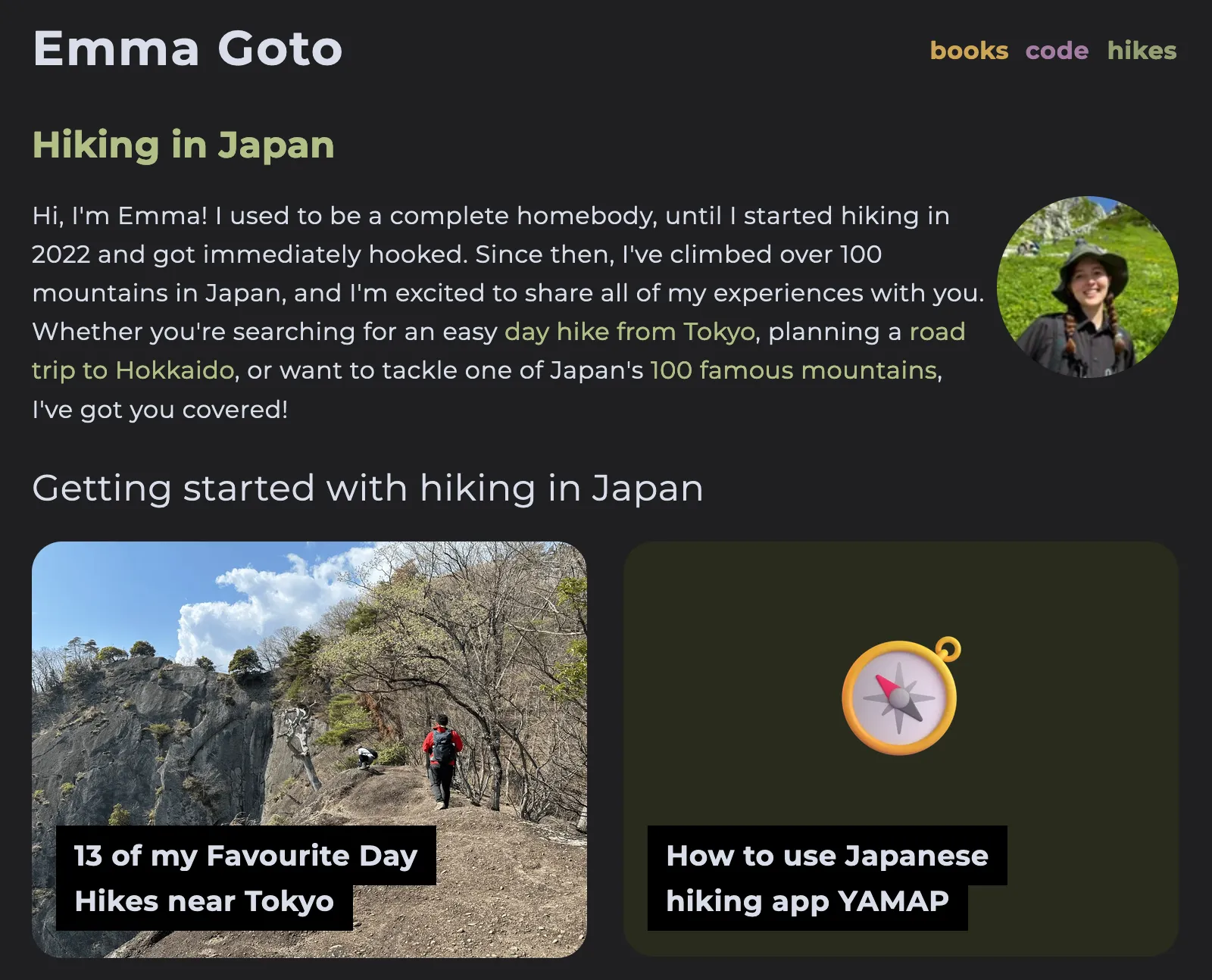
Books section
I recently did a design overhaul of my books section because I found it quite bleh and boring before.
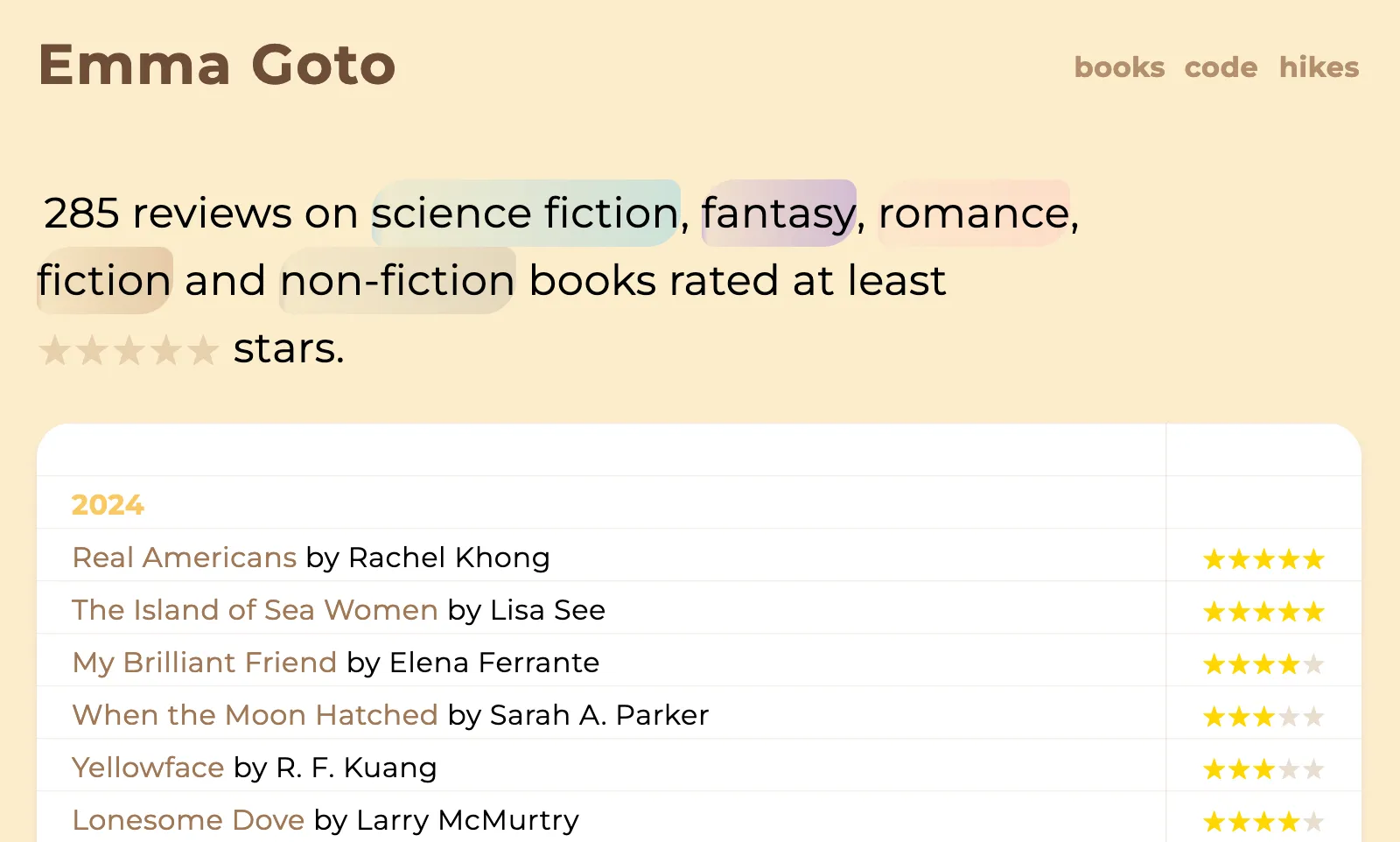
And if you click a book, a notebook pops up! I’m quite happy with this one ✨
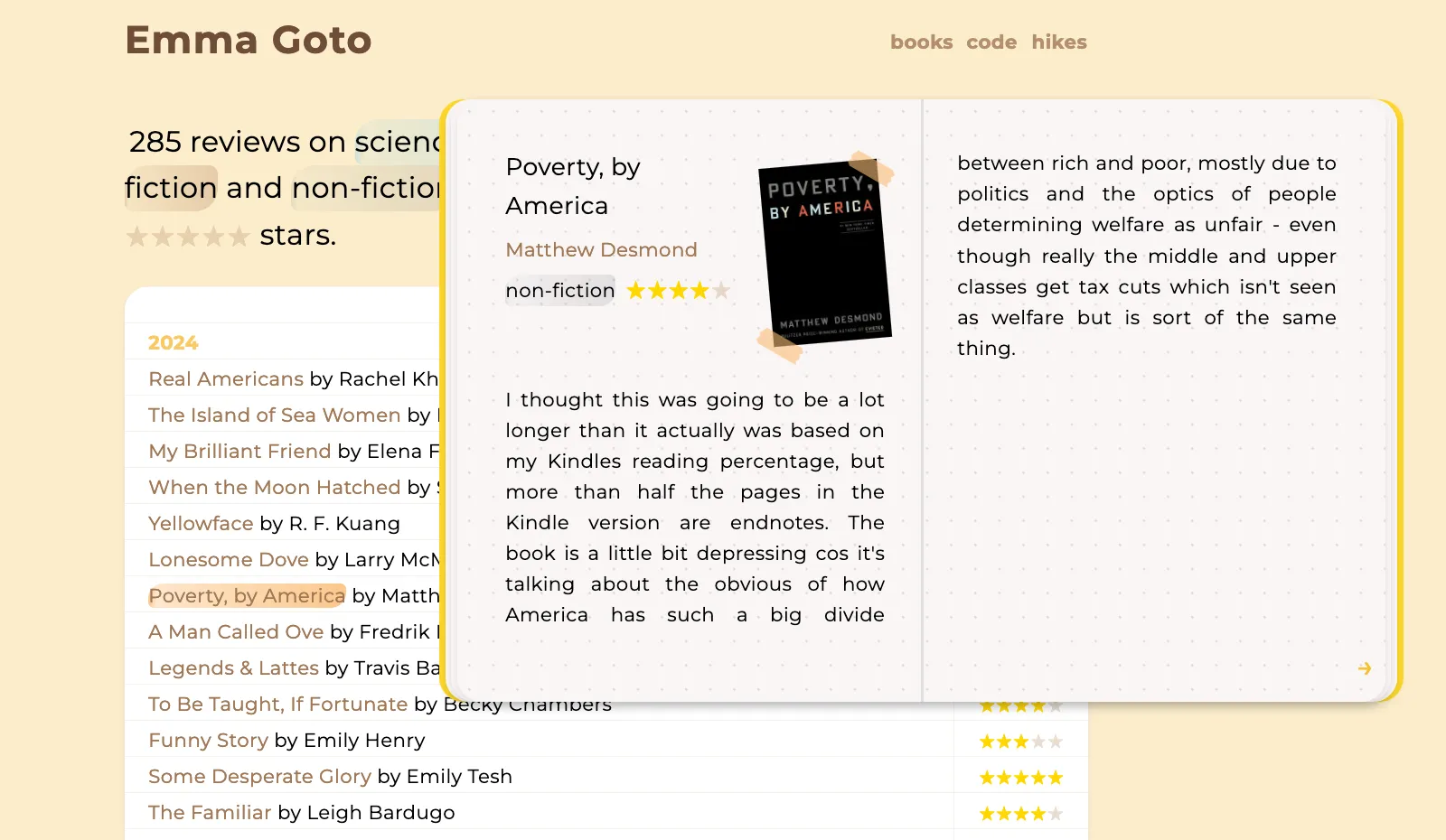
To be honest, I’m not really expecting my books section to ever get a lot of viewership, so this is the most personal part of my garden, that I’ve done just for me.
Programming section
The programming section is the original design of blog from pre-2024, back when emgoto.com was entirely a programming blog. A lot of the stuff that I have written is quite old at this point - although I have made recent updates to the ones still popular in 2024 like the table of contents post. So for the moment I’ve settled on having a “featured” section on my home page.
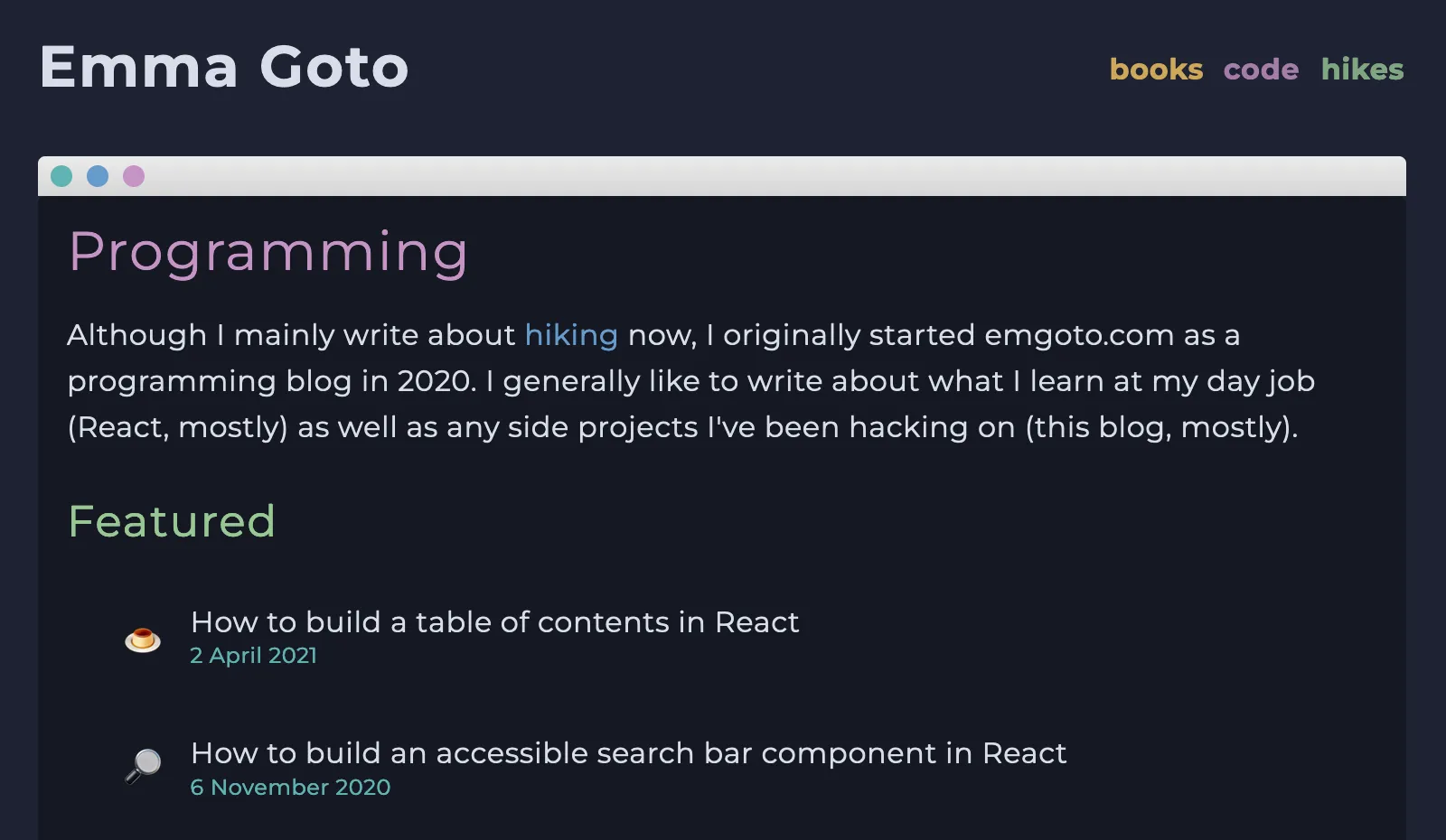
My main concern at the moment is growing my hiking section though, so I’m less concerned about the layout for the programming section - although this section of the blog still by far gets the most amount of hits, so I do try and tend to it a little bit as well!
Conclusion
I started off writing this post feeling fairly anti-digital garden, but the more I wrote, the more I felt the way I blog does actually align with a digital garden philosophy. Although I will never go full wiki-mode like some digital gardens, at the end of the day a digital garden gives you the freedom to blog in whatever way you see fit. If I see value in having a reverse-chronological feed on my home page, then why not?
As I continue to tend to my garden over time, I may find that I want to change how I structure my blog or my posts - and it’s ok if I do. It is my garden, after all.